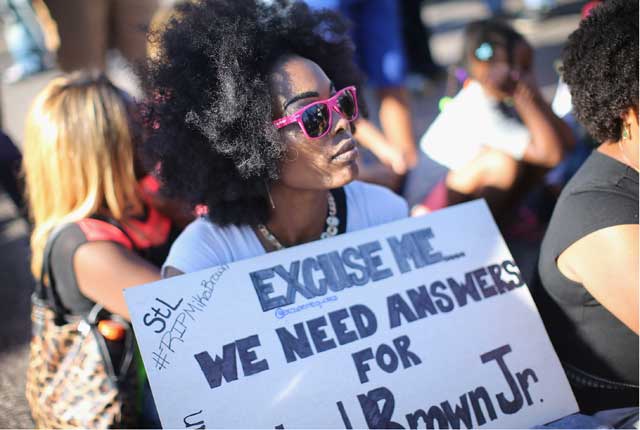A new eyewitness last night shared her account of the shooting death of unarmed teen Michael Brown by a Ferguson, Missouri, police officer. Tiffany Mitchell’s description of Brown is graphic, cautions local station KMOV, and matches the statement given by Brown’s friend, Dorian Johnson. After last night’s arrests and tear-gas volleys and today’s presidential address, the court of public opinion is in highest gear. Here’s what to keep in mind as you wade through (and for those just joining, start here):
The militarization of local police forces has a long history–and libertarian Sen. Rand Paul is calling for its end. In St. Louis County, according to an August 2013 report, about neighbors shaken up by the sight of heavily armed officers, police have been using SWAT teams to serve felony warrants, no matter what they’re for. This June, the ACLU issued a comprehensive report, War Comes Home–and they don’t mean St. Louis.
Ferguson is not Watts, 1965. It’s not even Crown Heights, 1991. Today’s St. Louis American editorial provides perhaps the best first draft of history you’ll read explaining why Ferguson residents stood together in the hours following Brown’s death. Ferguson fits into the well-documented history of police abuse triggering demonstrations and riots. But pay attention too, to Ferguson’s differences. They may indicate whether we’re witnessing something new.
Among many African-Americans, feeling themselves drown in a waterfall of murdered unarmed men and women, pushback against the Obama model is gaining fresh ears. From Duke University professor Mark Anthony Neal:
Six years into the Obama Presidency, we now realize that pulled-up, belted pants, neatly-pressed dress-suits and bow-ties are apparently a policy initiative intended to save Black men and boys. President Obama was seemingly shamed into the creation of My Brother’s Keeper (MBK), in the aftermath of the Trayvon [Martin] shooting and with the stark realization (via every index imaginable) that the lives of Black youth were not significantly better under his leadership, and perhaps worse.
Finally, consider how Michael Brown’s death in suburban, out-of-the-way Ferguson became news in the first place–and be wary of threats to the spread of that information. Zeynep Tufekci’s*, "What Happens to #Ferguson Affects Ferguson" is a great primer on legislative and corporate efforts to further restrict Internet freedoms. Also, the arrest-and-release of mainstream journalists rightly provoked the Twitterati’s furor last night and drew President Obama’s attention today. But many if not most journalists capturing the pulse of communities like Ferguson do not work for mainstream media. They’re freelancers or citizen journalists like Alderman Antonio French, also arrested and held last night. From Tufekci*:
The citizen journalists held on, even as choked from the gas, some traditional media started going live from the region, and today, [Ferguson’s] on the front page of many newspapers.
As always, feel free to share your own must-click links. See you back here tomorrow.
* Post has been updated.
